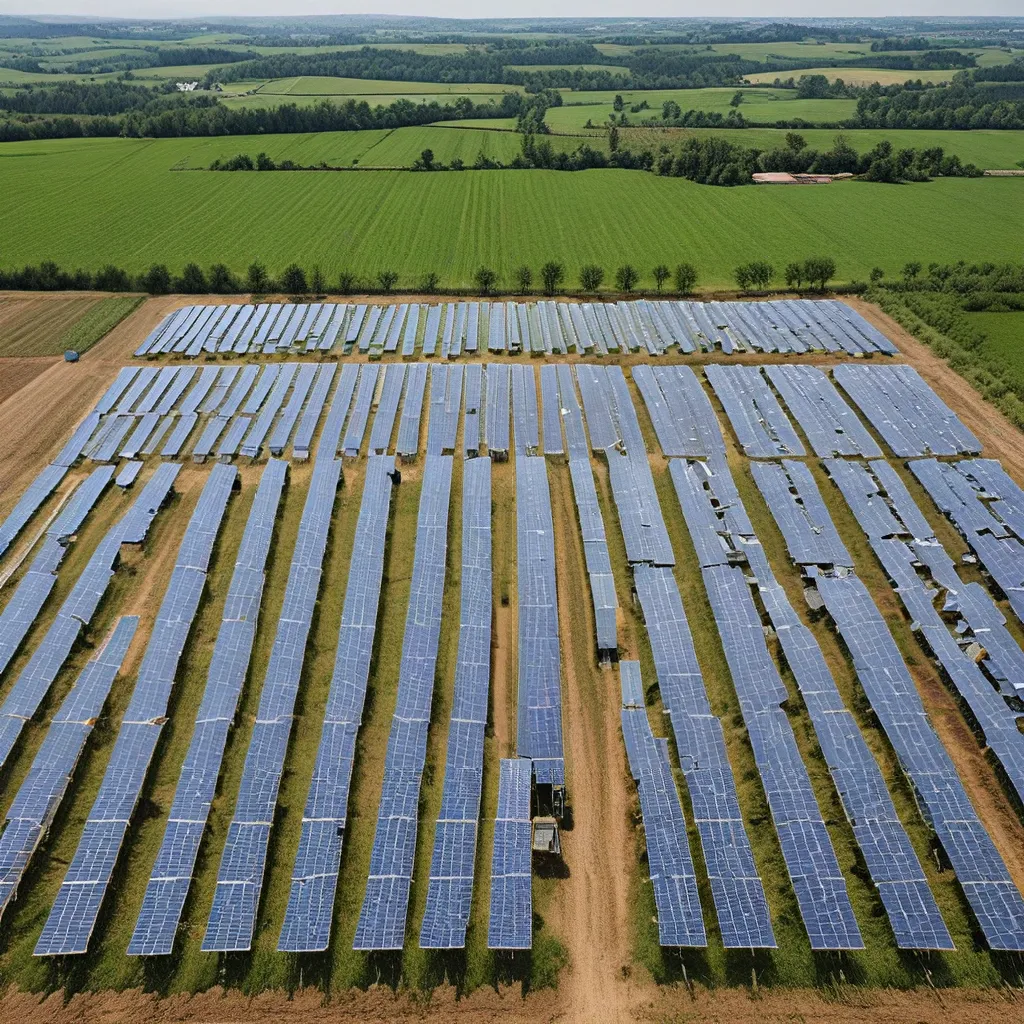
Harvesting the Sun’s Bounty
It’s a scorching summer day in the sun-drenched foothills of Colorado’s Front Range, and I’m standing in the middle of a bustling farm. Rows of lush spinach, sage, and strawberries sway gently in the breeze, while bees and butterflies flit from flower to flower. But this isn’t your typical pastoral scene – overhead, a canopy of solar panels casts a patchwork of shadows across the verdant landscape. Welcome to Jack’s Solar Garden, a pioneering example of agrivoltaics – the harmonious integration of agriculture and solar power generation.
As I wander through the five-acre site, I’m struck by the delicate balance at play. The solar panels don’t just provide clean, renewable energy – they also create a microclimate that helps the crops retain water and carbon, boosting yields and sustainability. It’s a symbiotic relationship that’s redefining the way we think about our energy infrastructure and its impact on the natural world.
According to the University of California, Davis, agrivoltaics can be a key part of the solution to one of the biggest challenges facing our transition to clean energy: minimizing the loss of valuable farmland and disruption to ecosystems. As the United States races to build out the renewable energy capacity needed to reach net-zero emissions by 2050, the demand for land to host solar and wind farms is skyrocketing. Estimates suggest we’ll need over 250,000 square miles of land – an area roughly the size of Colorado and Montana combined.
Cultivating a Sustainable Future
But what if we could use that land more efficiently? That’s the question driving the innovative work happening at Jack’s Solar Garden and other agrivoltaic sites across the country. By carefully designing solar installations to coexist with agricultural production, we can create a win-win scenario for the environment, the economy, and local communities.
“Agrivoltaics can boost clean energy production and benefit nature at the same time,” explains Duncan Gilchrist, a climate and natural resources policy associate for The Nature Conservancy in Colorado. “The shade provided by the panels helps plants retain carbon and water, which can increase crop yields and carbon sequestration. And by selecting the right plants, we can even enhance biodiversity on these sites.”
At Jack’s Solar Garden, for example, the team has turned over 25,000 pounds of vegetables, herbs, and berries since 2021, thanks in part to the farm’s partnership with the urban agriculture nonprofit Sprout City Farms. The property also hosts a large pollinator habitat and serves as a hub for research, education, and sustainable food production projects. It’s no wonder it’s the most visited solar array in the country.
Retrofitting for a Brighter Future
But what about existing solar farms that weren’t built with agriculture in mind? Can we retrofit these sites to create the same kind of dual-use magic? That’s exactly what The Nature Conservancy set out to explore with a pilot project just 10 miles southwest of Jack’s Solar Garden.
The half-acre site, owned by Boulder Housing Partners, sat on rocky, degraded soil – the kind of land that would seem ill-suited for anything but solar panels. But the TNC team, along with a diverse group of partners, was determined to prove that even the most barren solar fields could be transformed.
“We wanted to demonstrate the added value offered by agrivoltaics, improve the soil health and biodiversity of the site, and provide a benefit to the local community,” says Gilchrist.
The World Economic Forum reports that the team got to work amending the soil, bringing in 150 cubic yards of compost and wood chips to help it retain moisture and nutrients. They then carefully selected a diverse array of perennial plants – from fringe sage to scarlet globe mallow – that could thrive in the solar-panel microclimate without interfering with the panels themselves.
A Blooming Success
After just one year, the results were impressive. Over 83% of the plants had survived, and the site was teeming with a renewed biodiversity of insects, pollinators, and other species. The team had successfully transformed a forgotten corner of the solar farm into a vibrant, productive ecosystem.
But the real triumph was the impact on the local community. “We wanted our project to deliver tangible benefits to the people living in the affordable housing nearby,” Gilchrist explains. “So we provided paid opportunities and workshops that brought community members out to the site to help implement the vision.”
The project’s success has already led to major policy advancements in Colorado. Gilchrist and his team leveraged the partnerships and insights from the pilot to help pass a bipartisan state bill that allocated $1 million over two years toward agrivoltaics research and demonstration projects. It’s a testament to the power of creative thinking and community engagement when it comes to building a sustainable energy future.
Cultivating a Brighter Tomorrow
As I bid farewell to Jack’s Solar Garden and the Agrivoltaics Retrofit Partnership project, I can’t help but feel a renewed sense of optimism. These innovative approaches to integrating agriculture and renewable energy aren’t just about cheap electricity – they’re about creating a harmonious, regenerative system that benefits the land, the people, and the planet.
And it’s not just happening in Colorado. Across the country, forward-thinking companies and communities are exploring the potential of agrivoltaics to transform the way we generate and consume clean energy. It’s a future where the sun’s bounty nourishes not just our bodies, but our spirits and our ecosystems as well.
So, the next time you see a solar farm, don’t just think of it as a necessary sacrifice for the greater good. Think of it as a canvas waiting to be reimagined – a space where we can cultivate clean power, grow healthy food, and nurture the natural world. It’s a future that’s within our grasp, if we have the vision and the courage to reach for it.